|
Thursday, Sept. 25
- Breakfast: Canadian bacon, egg and cheese Texas toast
- Breakfast: Mexican omelet
- Steak soft tacos
- Braised beef with vegetables
- Kielbasa and braised cabbage
- Beef and cheddar wrap
- Sweet and sour chicken
- Chef's choice soup
- Beef barley soup
- Assorted pizza by the slice
Wilson Hall Cafe menu |
|
Friday, Sept. 26
Dinner
- Cold cucumber soup
- Linguine with clam sauce
- Sauteed asparagus spears
- Lemon blueberry cake
Wednesday, Oct. 1
Dinner
Menu unavailable
Chez Leon menu
Call x3524 to make your reservation.
|
|
Fermilab Scientist Emeritus Jeffrey Appel honored by Brazilian Physics Society
 |
|
Jeffrey Appel
|
Fermilab's contribution to the development of high-energy physics in Brazil was recognized by honoring Fermilab Scientist Emeritus Jeffrey Appel at the recent meeting of the Division of Particles and Fields of the Brazilian Physics Society.
The DPF identified Appel as one of the key people in this success, both while he was head of the Physics Section and later the Experimental Physics Projects Department of Fermilab's Particle Physics Division. Appel is the first non-Brazilian to be honored in this way by the Brazilian DPF.
At the ceremony, João de Mello of the Federal University of Rio de Janeiro noted that more than 50 Brazilian physicists are Appel's "scientific grandsons." Appel was the advisor of many Brazilian high-energy physicists that today are working in many worldwide projects, including CMS, DZero, LHCb, MINERvA and the Pierre Auger Observatory.
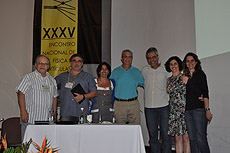 |
| Jeffrey Appel is surrounded by some of the colleagues who honored him at the recent meeting of the Division of Particles and Fields of the Brazilian Physics Society. João de Mello, Alberto Reis and Alberto Santoro paid tribute to Appel's scientific achievements and the growth of collaboration between Fermilab and the Brazilian particle physics community. From left: Alberto Santoro (State University of Rio de Janeiro), João de Mello (Federal University of Rio de Janeiro), Jussara Miranda (Brazilian Center for Physics Research), Jeffrey Appel, Alberto Reis (Brazilian Center for Physics Research), Sandra Amato (Federal University of Rio de Janeiro) and Carla Gobel (Pontifical Catholic University of Rio de Janeiro). Photo: Ellen Pirani, Brazilian Physics Society |
|
Magician Mike Super, seen on 'America's Got Talent,' comes to Ramsey on Saturday, 8 p.m.
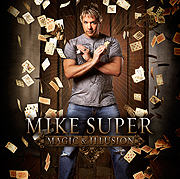 |
| Magician and illusionist Mike Super, recently seen by millions as a finalist on "America's Got Talent," will astound with tricks and legerdemain in Ramsey Auditorium on Saturday, Sept. 27, at 8 p.m. |
You can't see him on "America's Got Talent" anymore, so see Mike Super at Ramsey Auditorium on Saturday, Sept. 27 at 8 p.m. as part of the Fermilab Arts Series.
Mike Super's life has been characterized by an obsession and passion for magic. He has astonished millions of people with his craft, including the Hollywood elite.
Recently a finalist on this season's "America's Got Talent," Mike Super will entertain you with astonishing tricks and confounding illusions.
Mike Super's ever-growing popularity has garnered him many prestigious awards and honors, including being the only magician in history to win a live magic competition on primetime U.S. network television. He was also voted America's Favorite Mystifier on NBC's hit TV show "Phenomenon." Despite this, the illusionist humbly insists it is the loyalty of his fan base that has been most rewarding. His millions of fans call themselves the "Superfreaks."
Mike Super's natural ability to entertain and fascinate people has allowed him to pioneer a new form of magic. His inimitable, down-to-earth style, personality and humor reaches out and enchants the public.
Tickets for this Fermilab Arts Series event are $35 or $18 for those 18 and under. For more information or to make reservations, visit the Fermilab Arts Series Web page or call 630-840-2787.
|
Sept. 25, 1992: The Lederman Science Education Center is dedicated
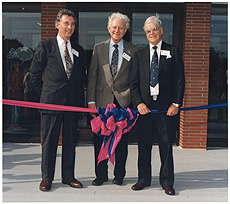 |
| Then-Fermilab director John Peoples and former directors Leon Lederman and Robert Wilson attended the Lederman Science Education Center ribbon cutting ceremony in 1992. Photo: Fermilab |
Today is the 22nd anniversary of the dedication of the Lederman Science Education Center. The ceremony recognized the contributions of Fermilab's second director, Leon Lederman, to precollege science education, including starting the Fermilab Saturday Morning Physics program and the Illinois Math and Science Academy.
Fermilab director John Peoples, Fermilab Education Program Manager Marge Bardeen, Secretary of Energy James Watkins and Lederman all spoke at the ceremony. You can read more about the event in two articles from the Oct. 2, 1992, issue of FermiNews. The event's program, John Peoples' remarks and other materials related to the dedication ceremony are available in the Fermilab Archives.
—from the Fermilab History and Archives Project
|
Full-galaxy dust map muddles search for gravitational waves
From Nature, Sept. 22, 2014
A map of interstellar dust unveiled today has substantially lowered the chances that a South Pole telescope glimpsed the imprint of gravitational waves from the dawn of time, as was claimed in March. The latest map, obtained with the European Space Agency's Planck space observatory, could, however, guide astronomers to the regions where they might have the best chance of detecting such a primordial signal.
Read more
|
|
What is the holographic principle?
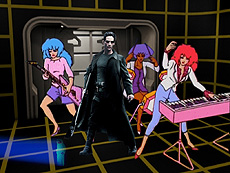 |
| This is not what scientists mean when they ask if the universe is holographic. |
Sometimes, news reports of scientific findings are oversimplified, exaggerated or just wrong. The most extreme disparity that I have seen is between the holographic principle of theoretical physics and how it is usually presented in the news. Most of the news articles on this topic include a statement about "living in a hologram" or a simulated universe, like The Matrix, which isn't what the physicists mean at all.
The physicists are referring to a surprising relationship between gravity and quantum mechanics. Gravity is known to be a consequence of curved space-time — for example, the Earth curves nearby space and time, which bends the trajectories of tossed objects downward. However, gravity is not well understood on extremely small scales, such as the distance between subatomic particles. The quantum mechanical interactions of the other three forces are understood on small scales, but not for strong fields.
The surprise is that there is a correspondence between the mathematical theory of gravity (specifically, for space-time with an anti-de Sitter shape) and the mathematical theory of quantum fields (specifically, for field distributions that have a conformal symmetry). A correspondence means that although the theories have different interpretations, equations in one theory can be translated to the other theory by a dictionary that relates terms in one with terms in the other. This relationship is incredibly useful because hard problems in gravitational physics often translate to easy problems in quantum field theory and vice-versa, so physicists can now solve more problems.
What does this have to do with holograms? The word "holographic" is used because this dictionary translates three-dimensional gravity problems into two-dimensional field theory problems. Similarly, a hologram produces a three-dimensional image from a two-dimensional film or glass plate. The three-dimensional information in the hologram (for instance, what an object looks like from all angles) must be flattened into the two-dimensional film that is used to project it. The dictionary that relates gravity to field theory must also flatten three-dimensional information about the gravity problem into the two dimensions of the field theory problem. Thus, the phrase "holographic principle" is meant metaphorically.
This correspondence is not certain or completely understood, so experiments like Fermilab's Holometer are looking for evidence of quantum mechanical features in space-time — specifically, fluctuations in the distance between two mirrors. Also, it's not just a clever trick to solve more physics problems with a wider set of tools: It could explain why the information content of a black hole is related to its surface area (two-dimensional) rather than its volume (three-dimensional).
There's nothing wrong with wondering, philosophically, whether the world as we know it is a Matrix-style simulation. It's just a different question from the one physicists are trying to address when they investigate the holographic principle.
—Jim Pivarski
|
Summer scape
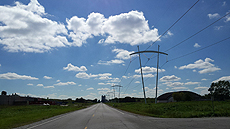 |
| All lines point to Wilson Hall on a late-summer day. Photo: Lauren Biron, Office of Communication
|
|
Down in the dark matter lab
From Boing Boing, Sept. 19, 2014
I'm standing apprehensively in the gloomy dark, my entire body vibrating with the shuddering metal cage I'm in, and surrounded by an overwhelming roar of air that's not so much heard as felt. I turn my head to peer out through a gap in the cladding and see the enveloping cliff of rock rushing past. This is the lift serving the Boulby Mine on the north-east British coast, one of the deepest in Europe. The gale of air buffeting my clothing is from huge compressor fans ramming air down the shaft to ventilate the miles of tunnels below - to even get to the lift shaft we had to pass through a double set of airlock doors, our ears popping with the pressure pulse as we equalized.
Read more
|
|